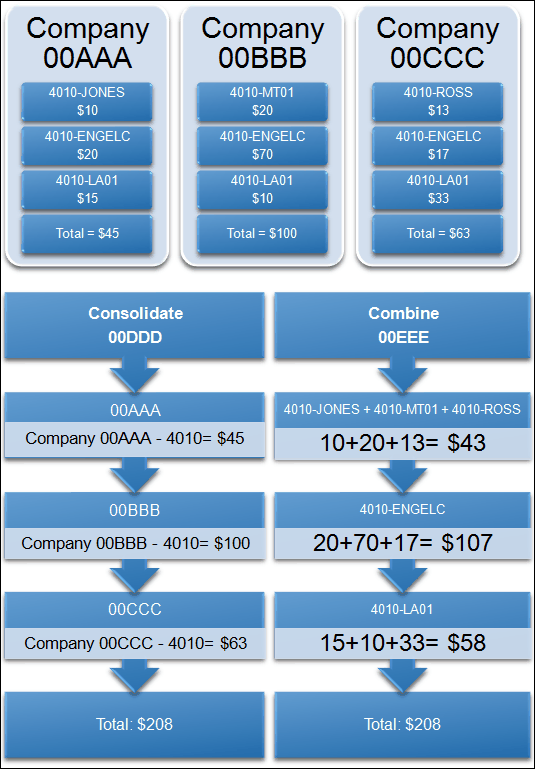The Consolidation module automatically creates the necessary entries to consolidate multiple companies together in summary form under one company code. During the consolidation process, there are “From” (subsidiary) companies and an “Into” (parent) company. The Subsidiary companies are usually normal sets of books. The parent company is a newly defined company used to print the consolidated statements. The consolidation process creates entries for the Parent company’s books that reflect each Subsidiary’s monthly activity for each account. The system uses the Subsidiary company’s code as the Sub-Account when creating entries for the parent company.
The Combination module is used to combine multiple sets of books together on the Sub-Account or cost center level. The primary purpose is to combine various legal and accounting interests in the same cost center together so management can see the true picture of the cost center’s contribution to the combined organization. For example, a corporation owns various oil & gas leases and it has sold a portion of the revenue but not the associated expenses (i.e. overriding interest) to its sole stockholder. At some point, the property will have a negative cash flow on the corporation’s books but retain a positive cash flow on the individual’s. With the use of the Pak Accounting Combination module, a third set of books can be created very easily for management reporting only.
Consolidation vs. Combination |
|
|---|---|
Similarities |
•Combines multiple sets of books together into one new consolidation / combination (parent) company. •Both can have unlimited parent companies. •Summaries are stored in a separate company code. •The CONSOL / COMBINE Sub-Table is used to identify the companies that will be consolidated by their company code and will be automatically setup when the consolidation / combination company is created. •Identifies the companies that will summarize into the consolidated or combination parent company. •The same report definitions and utilities can be used. Consolidation data will be reported by company. Each company is a different cost center. Combination reporting will retain the original cost centers. This will allow for more complex reporting and the use of financial groups if there are unique costs centers in each company being combined. •When entering the Consolidated / Combined company you will be asked if you want to consolidate / combine. Select "Yes" every time changes are made to the companies being consolidated / combined. •It is helpful to use a similar chart of accounts. However, if this is not possible accounts or account ranges can be recoded (cross referenced) on the Consolidation / Combination tab of each individual company's Sub-Table maintenance in the Consolidated / Combination company. •An elimination company can be used with consolidation / combination to book adjustments in order to convert a company from accrual to cash. |
Differences |
•Consolidation summarizes at the company level into one company code. •Combination summarizes at the cost center level. If the same costs center exists in multiple companies, the numbers will be combined. |
